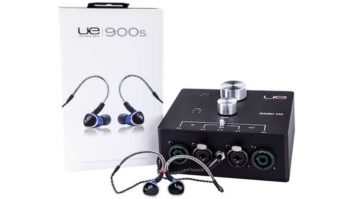The idea of being able to record anywhere is compelling. Whether you do field recording or just want to be able to work on music projects outside of your studio (and I mean anywhere outside of your studio, as long as you’re not underwater), CEntrance’s MixerFace R4 Mobile Recording Interface ($349) lets you go forth untethered and record with high quality into your laptop, mobile device, portable recorder or video camera.
The handheld, battery-operated R4 offers impressive-sounding mic pre’s and converters, and plenty of handy features. The unit replaces the company’s previous—and much more expensive—mobile interface, the D2.
Two Neutrik combo inputs with globally switchable phantom power allow you to connect XLR mics or guitars, basses and other Hi-Z sources.
The inputs each have a High-Pass Filter switch and a Gain knob. You also get a Blend control for each channel, allowing you to adjust the balance of the input to the signal returning from your computer or mobile device—making direct, zero-latency monitoring easy. An overall volume control, labeled Monitor ,is handy, especially when you turn one of the channel’s Blend knobs more toward the channel setting and hear less of your existing tracks coming back.
Read more Mix Blog Studio: Farewell to Noise.
The R4 also includes an Aux-in circuit, accessed with a 1/8-inch jack and controlled by a volume knob. It’s handy for patching in recorded music, which you can practice along with using an instrument or mic plugged into one of the inputs. Alternatively, you could use the R4 as a mixer for up to two live sources and a stereo pair (most likely recorded music) through the Aux inputs.
For outputs, you get an 1/8-inch headphone jack and left and right 1/8-inch TRS balanced outputs for feeding monitors or any other external gear. An additional stereo 1/8-inch line out is included for connecting to video cameras and other gear with stereo 1/8-inch inputs.
The R4 has a built-in, rechargeable battery that is not user-replaceable; it’s designed to provide eight hours on a single charge. You charge it with the included USB-to-mini-USB cable, which is also what you use to connect the R4 to your computer or mobile device (you need adapters—not included—for both iOS and Android). The battery takes about five hours to re-charge completely; it’s probably wise to try to start any field projects with it fully charged.
To keep the unit’s size down, CEntrance used recessed mini-levers as switches for the High-Pass Filters, Phantom Power, Stereo/Mono monitor, and line/mic output (which allows you to output to DSLRs or other devices with mic-level inputs). These switches are a bit of a pain, because they’re really small and require that you use a pen tip or similarly small object to flip them to “prevent accidental adjustment.” I would prefer taking my chances with accidental adjustment rather than needing a separate implement in order to turn on important functions.
Nightmare scenario: You’re trekking through the Alaskan wilderness, you’ve finally tracked down the rare Eurasion Bullfinch after years of searching, and you’re all set to record its call. Suddenly you realize you don’t have a pen or other small object to turn on the phantom power.
Another minor issue is that the unit is quite light and has no non-skid features such as rubber feet on the bottom, so it’s easy to accidentally pull it off a table, if, for example, you do what I did and stand up with your headphones on and walk away, forgetting that they’re plugged into the R4. (Thankfully, I caught the unit before it hit the ground.) If you’re using it with a camera, there is tripod mount on the bottom.
Overall, though, the design is impressive and the sonic quality even more so. I recorded a couple of short musical pieces into my laptop using the R4 as the interface, and the quality of the recordings, both with the mic and the instrument inputs was outstanding. I really like the sound of the preamps and converters.
With a mic (an Oktava MK-012), I recorded acoustic guitar, resonator guitar and vocals, and all sounded roughly comparable to the quality I get through my desktop interface, which is no cheapy. Through the instrument inputs I tracked DI electric guitar and bass, with equally happy results.
I’m sure the R4 will be quite popular with videographers, as it allows for high-quality audio capture in a convenient form factor with easy connection to the camera’s audio input.
For mobile music sessions up to two inputs, or live stereo recordings of performances, it should also be quite well-received. Used in tandem with a laptop, phone or tablet, it creates a small, powerful and highly portable recording setup.







